
|   |

|   |
Omkara: Dance divine - Ranee Kumar e-mail: ranee@journalist.com Photos: Vinay Tiwari June 6, 2024 Two complimenting yet contrasting forms - the feminine (lasya) Odissi and the masculine (tandava) Seraikella Chhau met each other on the same stage at an evening of dance aptly titled 'Omkara' - a two-day festival. It was veritably a sprinkling of showers in mid-summer. The scorching heat of the capital did not deter the dance aficionados' full attendance at the IIC auditorium! Not for just one evening but the next day too. It was Odissi dance throughout but what was so evident was the individualistic style each brought to their performance where no two looked repetitive or monotonous. In fact, the audience approached each artiste and her troupe with equal animated enthusiasm and eagerness. The disciples of Guru Sharon Lowen set the stage afloat with a graceful invocation to lord Vishnu who is the epitome of peace and through the Padma Patra Mangalacharan set to raag Bairagi and Bhupali. The lamp lighting ritual emanated vibrant signals of the feast to follow. The inimitable Guru Ranjana Gauhar and disciples were the star performers for the first half of the evening. Vrinda Chadha has emerged as a dancer to look out for - her abhinaya and her calculatedly graceful movements enhanced the Ardhanarishwara nritya (Champeya gourarda...) along with Vinod Kevin Bachan. Kevin proved to be a vigorous dancer who could balance the feminine element and adapt it to his structure commendably. Together, the duo paired perfect from their green costume to their contra-directional moves in absolute sync. Postural stances uplifted the verses from Adi Sankara's composition extolling the iconic Shiva-Shakti fusion. Going by the slokas, the Ardhanarishwara are juxtaposed, not opposed to each other. So, it would be more indicative of the iconic concept if the artistes danced in as fused beings or in tandem. 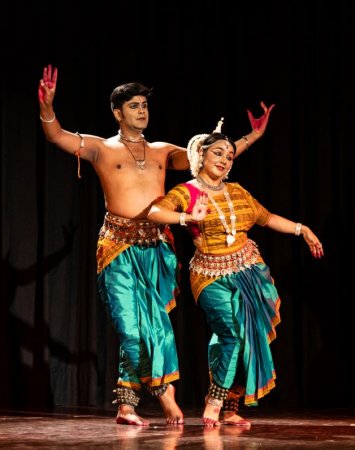 Vinod Kevin Bachan & Vrinda Chadha 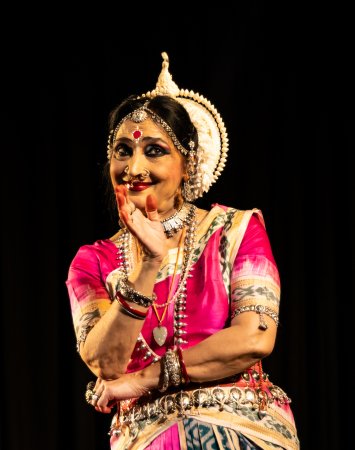 Ranjana Gauhar For the Shankarabharanam Pallavi, Urjaswi Dutta merged in with the duo and the nritta display was inlaid with intricate rhythmic patterns as the trio moved in tandem with perfect cohesion. Ranjana Gauhar took up Jayadeva's ashtapadi 'Rati sukh sare...' in raag Kalyani, interlacing the rich tapestry of the song with her superb abhinaya. The varied ways in which she showcased the single 'Dheera sameere Yamuna teere...' refrain was enough to prove her unquestionable prowess with the art form. One could actually visualise the caressing winds kissing the banks of the river Yamuna through the artiste's sensitive depiction. The sensitivity with which she brought out the three hidden characters in the song - the sakhi, Radha and Krishna - was amazing. The ashtapadi flowed eloquent vested with the elegance of Ranjana's mime and movement. The martial Seraikella Chhau in the second half of the evening was a stark antithesis to the delicate Odissi. The native, raw flavour endowed it with a rustic charm which had to be viewed in order to believe. Opening to the customary Jatraghat invocation to lord Bhairav, the Trinetra Chhau Dance Centre artistes treated us to a kaleidoscopic masked dance with live orchestra which was in itself quite unique. If Hara Parvati divine union with measured angular movements interspersed with jerks was danced to percussion sans song was awe-inspiring love of divine static and kinetic energies merger, Chandrabhaga was a pathetic love saga between the Sun God (represented in the temple of Konark) and the maiden Chandrabhaga which ends on a tragic note. It underlines the futility of human life vis-à-vis the heavenly bodies whose effulgence is as much tempting as it can be tempestuous. Sudeep Kabi and Pradeep Kabi as the hero and heroine played their roles to a T. One could never guess that a male donned the role of Chandrabhaga!  Trinetra Chhau Dance Centre 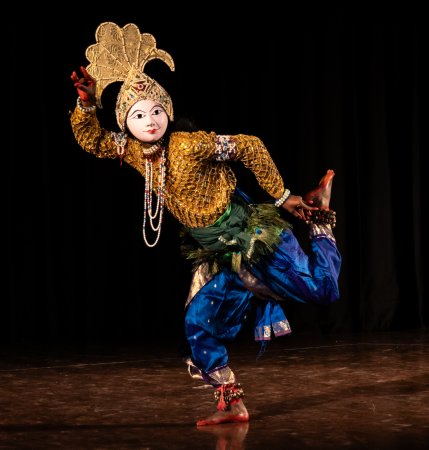 Trinetra Chhau Dance Centre The body gestures though typical of Chhau style had their individualistic features etched into them, in keeping with their roles. Surya with the prop of rays behind his head appeared rustic but cute. So too the raw natural pursuit of the male and female prior to their union was brilliantly brought out by Nibaran Mahato and Sanjay Karmakar in Hara Parvati. The tiger skin attire for Hara further enhanced the character. The Mayur (peacock) dance was not anywhere like our other dance styles - it was vested with an atavistic beauty, like the moods of the peacock anticipating the approach of monsoon. The dancer Bijay Sardar gave a wonderful performance as Mayur aptly tuned to the raag Megh. There was a thematic follow-up to the Mayur with Barsa Jham Jham and Hunter that ran parallel to one another. While the peacock dance heralded the rain, Barsa actually encapsulated the showers on a cloudy night; raindrops evoking the erotic love in the lovers (Anjali Desai-Pradeep Kabi) who find a reason to huddle together amid thunder and lightning seeking solace in each other's arms. The beat of the percussion and the flute were a fitting finale extolling the glory of love. The Hunter donned by Nibaran Mahato is the archetypal Seraikella Chhau piece where man stalks his prey in the thickets of the forest. The element of tandav style could not be missed in his dance. The darting looks and precarious moves of the Hunter dancer were reminiscent of the ancient hunting human. Without a word and commendation to the orchestra, there is no proper justice done to the performances. The unique music was enriched by Sunil Dubey on the harmonium, Deoraj Dubey on the flute, Binod Pradhan on dhol and Baburam Sardar on nagara. The performances were put together by Sunil Kumar Dubey. The concluding evening was divided between Manasa-Art without Frontiers team, disciples of Sharon Lowen and Odissi maestro Kumkum Mohanty and disciples. Though both the gurus have a common root and legacy in the redoubtable guru Kelucharan Mohapatra, their singular styles had a telling effect in their performances lending a dimension to their respective performances. The slokas from Tulsidas Rudrashtakam unveiled the sacred space to an enriching experience of quintessential Odissi. The notes of "Namaameesha meeshana nirvana roopam..." reverberated through the auditorium creating an aura as the dancers swayed in group of five reminiscent of the five faces of Rudra, the five principal elements of nature which is Shiva in manifest form. The body language and gestures were able to concretise the abstract in meaningful, expressive dance and mudras. Five dancers could appear as a crowd; to the contrary these five moved in alternate cycles of merge and distance so subtly that one could hardly discern the five from a single dancer! So was it when a sixth got added to the Taranga Pallavi in raag Bilahari. The syllabic utterances flowed through the footwork with effortless ease or vice-versa was hard to say. The sync was simply stunning from eye expression to torso movement to footwork and shifting positions to statuesque postures. It was one perfect group work that left nothing to be desired. Executing the chowki every now and then, there was never a slip where one dancer collided with the other even by accident. It showed high level of practice to perfection. Nitisha Nanda, Vishwanath Mangaraj, Pragna Ghosh stood out in their expertise while Aashi Kumar and Perrine Legoullon fell in line with them in equally fragile grace. 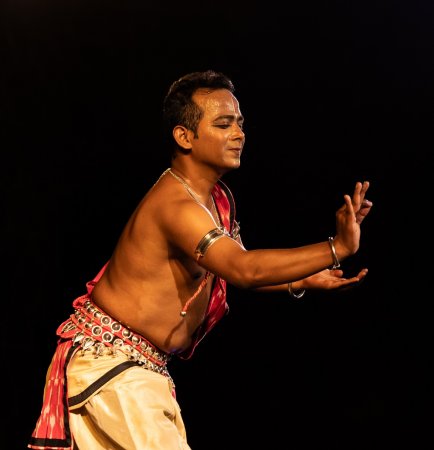 Vishwanath Mangaraj Vishwanath reminds one of Kelubabu in the making. His natural body kinetics seem moulded for Odissi and this makes him a spotless dancer. The emotive element is inborn too as he is a true artiste. And solo is where one gets to experience his rich talent. "Dheera sameere ..." found its eloquence in the way Vishwanath handled the ashtapadi set to raag Kalyan. To portray three figures viz. the intermediary, persuasive Sakhi, the slighted ego of Radha and the lovelorn Krishna all at once as the song flows through its lyrics is no mean skill. Vishwanath proved to be an adept at all three - lending suitable expressions to the women characters and living in the role of a love-lost, pining Krishna who is looking out for his Radha with every stir of a leaf, every fall of a feather and every blow of the breeze. These finest of fine sentiments and gestures were enacted with ease and elan by the artiste making for a memorable performance. The original Kelucharan choreography kept peeping through Vishwanath's abhinaya and movements. 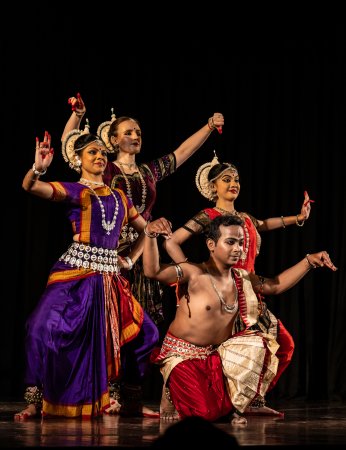 Disciples of Sharon Lowen 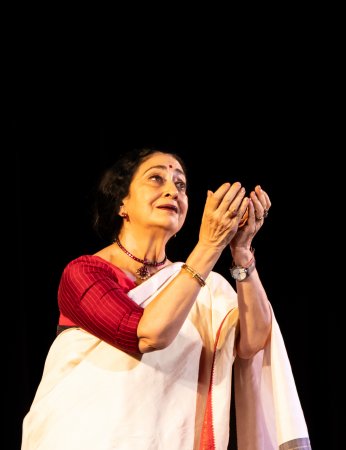 Sharon Lowen The highlight of the evening was Moksha by Sharon Lowen. The six dancers gliding in and taking stances facing six different directions lent a dramatic effect to the opening notes. It was amazing to see Sharon get on to the stage from the audience and take up this uplifting piece of Mangalampalli Balamurali's "Omkara rupini ..." (raag Bhairavi and Lavanya) in praise of mother goddess. It was an apt choice to a fest named Omkara! Sharon's soulful rendering of this piece, where she got simply immersed in the flow of the sloka was so touching that it naturally petered down to the audience. Many of us were found wiping the tears of sheer bliss that flowed involuntarily out of our eyes! Each line was poignant and the poise with which Sharon emoted was awesome. The ensemble was as strong as the choreographies with Prafulla Mangaraj on the mardala, Agnimitra Behera on the violin, Srinibas Satapathy on the flute and vocals by Sukanta Kumar and Ashish Nayak. 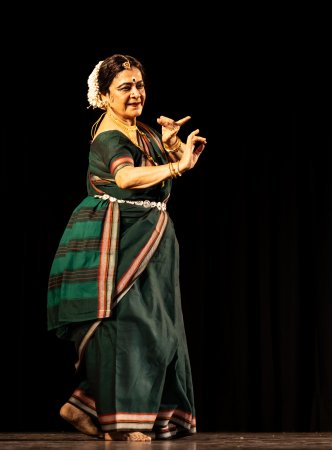 Kumkum Mohanty The climax was something we were all eagerly looking out for, as it's not every day that Delhi audience gets to watch Kumkum Mohanty dance. And dance she did, with a flourish! Her Yagnaseni was etched in detail with precision and perfection in every move and expression. Culled out of Mahabharata character of Draupadi, this solo was a piece of unique artistry where Draupadi is asked to deck up and spend a night each with each of her five husbands and come out untouched! Kumkum Mohanty enacted each night's adorning by Draupadi, with meticulous detail. Her vigorous footwork and her flexibility left us rooted to our seats. Here was a dedicated artiste who remained so without a dent through her changing years. Earlier, her disciples Lucky Mohanty, Anisha Anukampa who performed the Kirwani Pallavi along with Lopamudra Nayak and Swetaleena Pattnaik proved to be worthy pupils of their intellectual, artistic guru. Anisha and Lucky were grace incarnate as they executed the footwork patterns with the typical Odissi sway and swing. It was a pleasure to watch them. The abhinaya piece in Oriya - Shyama ka Juhar – by these four disciples brought out the khandita nayika in Radha with aplomb. It should be admitted that they did full justice to this essentially solo piece. Haripriya Swain flowed eloquent on the vocals, with mardala by Muralidhara Swain, violin by Agnimitra Behera and flute by Srinibas Satapathy. Omkara Odissi fest will be long remembered as a presentation par excellence, a metaphor for fluidity and finesse that was a delight to behold. 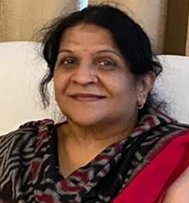 Ranee Kumar is a journalist who brings in three decades of hard core journalistic experience with mainstream papers like the Indian Express and The Hindu to arts reporting. Her novel 'Song of Silence' and guest editing of attenDance widen her horizon. |